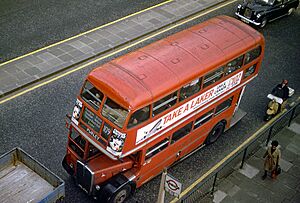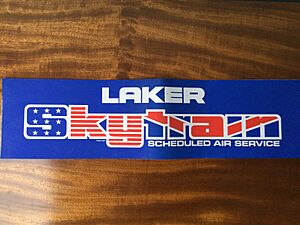Laker Airways facts for kids
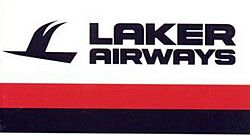 |
|
| Founded | 29 July 1966 |
|---|---|
| Ceased operations | 5 February 1982 |
| Hubs | London–Gatwick Berlin–Tegel |
| Secondary hubs | Manchester |
| Focus cities | Glasgow–Prestwick |
| Subsidiaries | [International] Caribbean Airways (part-owned) Laker Air Travel Ltd. Arrowsmith Holidays Ltd. Laker Holidays GmbH |
| Fleet size | 20 aircraft (14 widebodies and six narrowbodies) at 5 February 1982 |
| Destinations | Europe/North America/Asia |
| Headquarters | Gatwick Airport |
| Key people | Freddie Laker, Alan Hellary |
Laker Airways was a private British airline started by Sir Freddie Laker in 1966. It began by flying people and cargo all over the world as a charter airline. Its main office was at Gatwick Airport in Crawley, England.
In 1977, it became the second airline to offer long-distance, low-cost flights with no fancy extras. These flights were scheduled services between London Gatwick Airport and New York City's John F. Kennedy Airport. The first airline to do this was Loftleiðir from Iceland. In the early 1980s, the company went out of business during a tough economic time. Its last flight was on February 5, 1982.
Contents
- Early Days of Laker Airways
- How Laker Airways Operated
- Why Laker Airways Failed
- Incidents and Accidents
- Other Laker Airways Companies
- Planes Laker Airways Used
- Laker's Lasting Impact
- See also
Early Days of Laker Airways
Freddie Laker announced he was starting Laker Airways in February 1966. The airline began flying from its base at Gatwick Airport on July 29, 1966. Its first planes were two Bristol Britannia 102 series turboprop aircraft. These planes used propellers powered by jet engines.
The planes were painted black, red, and white, which were Laker's racing colors. From December 1967, the Britannias were joined and later replaced by five BAC One-Eleven 300 short-distance jet aircraft. Laker ordered three of these planes in 1966, costing £4 million.
Freddie Laker used over £200,000 of his own money for the plane deposits. Banks in the City helped pay for the rest. He ordered a fourth plane for 1968 and bought another one in 1971. These planes were mainly used for short and medium-distance charter flights. They flew to popular holiday spots in the Mediterranean and the Canary Islands.
How Laker Airways Operated
Laker Airways gave 30% discounts to tour operators who wanted to rent their planes in winter. This was when fewer people were traveling. They also offered other deals to encourage tour operators to use their planes for longer periods. This helped make sure the planes were used almost all year.

In August 1968, Laker Airways opened its first base outside the UK at Tegel Airport in West Berlin. The company kept up to three BAC One-Elevens there until 1981. Then, they replaced them with one of their new Airbus A300 B4 series wide-body planes. At the time, this was the biggest plane flying from any Berlin airport.
Their Berlin team had 90 workers, mostly from the local area. They flew thousands of holidaymakers from West Berlin to places in the Mediterranean and the Canary Islands.
Working on the Ground
In 1972, Laker Airways helped start Gatwick Handling with Dan-Air. This company helped handle planes at Gatwick Airport. Each airline owned half of Gatwick Handling when it started. Today, it is part of the Aviance group.
Flying Higher, Faster
In the past, airports and skies were not as busy. Laker Airways told its pilots to listen to other jet planes taking off ahead of them. They would even talk to the other plane's crew while climbing. The goal was to find out how high the other plane was. This encouraged the other plane to climb to its top height quickly. This way, Laker's One-Elevens could reach their best height faster. This helped Laker's planes climb quicker without using as much power. It saved fuel and reduced wear on the engines.
Saving Weight on Flights
Laker Airways used ways to make its planes lighter so they could fly further without needing to refuel. One way was to limit baggage to 40 lb (18 kg). This was less than the usual 44 lb (20 kg). They also carried fewer passengers than the plane could hold. This policy started when the airline began using its BAC One-Elevens. By limiting baggage and passengers, the company used the saved weight to carry more fuel. This increased how far the planes could fly.
This was enough for non-stop flights from London Gatwick or Berlin Tegel to Tenerife, at least in one direction. This depended on the wind's direction and strength. This helped Laker's One-Elevens compete better with larger planes. If there were more than 70 passengers, the company renting the plane had to pay for any stops. This encouraged them to keep to 70 passengers.
Also, saving weight by limiting baggage could mean using less fuel on shorter flights. This was true even with a full plane of passengers.
Using DC-10 Aircraft
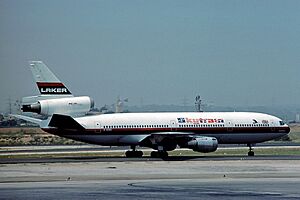
The weight-saving ideas Laker Airways used for the BAC One-Eleven also helped when they got the McDonnell Douglas DC-10-10.
This model could not fly as far as the DC-10-30. The DC-10-10 was best for medium-distance flights. Laker Airways bought two of these planes. They found they could fly non-stop from the UK to anywhere east of the Rockies. They did this by keeping the baggage limit at 40 lb (18 kg). They also reduced the number of seats from 380 to 345. The saved weight allowed them to carry more fuel. Calculations showed they only needed to fill 52% of the seats to break even.
The DC-10s also had a big chance to make their planned London – New York Skytrain flights more profitable. They expected to fill 70–75% of seats. They also thought 250,000 passengers would fly each way in the first year. This was almost three times what they first thought for the Boeing 707. These reasons made the company choose McDonnell-Douglas's offer.
A Laker Airways McDonnell Douglas DC-10 was one of four large planes flown in for the opening of the new terminal at Berlin's Tegel Airport. This happened on October 23, 1974.
Starting Skytrain Flights
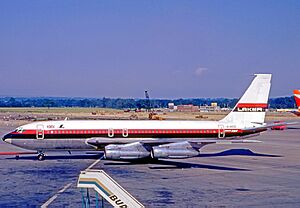
In the early 1970s, the airline and its owner fought with aviation authorities in the UK and US. They wanted to get permission for a low-cost, "no frills" transatlantic service. This service would link London and New York daily in summer and four times a week the rest of the year. It was called Skytrain and would cost £32.50 one-way in winter and £37.50 in summer.
Laker bought two Boeing 707-138B planes in 1969 for Skytrain. Sir Freddie announced Skytrain at a press conference in London on June 30, 1971.
Laker believed many people wanted this kind of service. He said it would increase the total number of passengers flying between Britain and the United States. He thought it would go from 14 million to 16 million, instead of taking passengers from other airlines.
Since Skytrain approval took several years, Laker Airways needed other work for its long-distance planes. At first, both Boeing 707s helped the BAC One-Elevens on Mediterranean and Canary Islands routes. They also replaced Bristol Britannias on longer flights. Many of these were group charters to North America.
In summer 1970, Laker asked for permission to operate group charter flights to Australia. After being refused, he flew to Australia in early 1971. He wanted to discuss his idea for 15-day inclusive tours from Australia to the UK. These tours would include full board at first-class hotels for A$935. However, his visit did not convince the Australian authorities. This was because BOAC and Qantas lobbied against it. They thought they had lost £11 million in revenue due to competition from charter airlines.
From December 1970, one of Laker's 707s was used for a weekly low-fare service. It linked Luxembourg with Barbados for International Caribbean Airways. This was a joint company between Barbados businessmen and Laker Airways. Laker Airways initially owned 33% of International Caribbean. This plane also flew regular charters from Canada and West Germany to Barbados. In January 1975, International Caribbean Airways became the official flag carrier for Barbados.
Laker Airways received a fourth McDonnell-Douglas DC-10 in 1976. This was to prepare for the launch of its daily London to New York Skytrain. This plane was the second test model of the DC-10. The airline bought it directly from McDonnell Douglas at a reduced price. By then, the number of workers had grown to 1,000.
Skytrain began flying between London Gatwick and New York JFK on September 26, 1977. It made over £2 million profit in its first year.
In early 1979, the airline ordered two more DC-10 series 10 planes. They also ordered five longer-range McDonnell-Douglas DC-10 series 30 planes.
Laker Airways expanded to Los Angeles in 1978. The company bought two used Boeing 707-351B planes from Cathay Pacific. This was to start non-stop flights to the US West Coast. This happened before they received their new McDonnell-Douglas DC-10 series 30 aircraft.
After a public meeting, the Civil Aviation Authority (CAA) approved Laker's request for unrestricted Skytrain services in July 1979. This allowed the airline to offer bookable seats, special fares, and cargo services. These were in addition to the original, non-bookable Skytrain fare from Gatwick to New York JFK and Los Angeles.
With the arrival of the series 30 DC-10s, new long-distance charter flights became possible. Harry Goodman, owner of Intasun, asked Laker about flights to the Caribbean and Florida. Goodman chose Florida, and Disney World charters were started for the UK market. This program quickly grew to seven flights a week. It eventually became a Skytrain service to Miami.
By October 1980, Laker offered fully bookable Super Economy fares on all Skytrain services. These were about half the price of competitors' standard economy fares. They were also much lower than other airlines' Super APEX fares. The airline set aside about 60% of its scheduled seats for these new bookable fares. This was a big change in the company's pricing strategy.
Tampa, Florida, was added in 1981 from Gatwick, Manchester, and Prestwick. By then, the company had sold both older Boeing 707-138Bs and one BAC One-Eleven. This left them with 20 aircraft: 14 wide-body planes and six narrow-body planes. This included 11 DC-10s, three A300s, two 707s, and four One-Elevens. The fleet size doubled in just five years. During this time, the number of people working for Laker Airways and related companies also doubled to 2,000.
During summer 1981, Laker operated up to three daily flights each way between Gatwick and JFK. They also had three daily flights between Gatwick and Miami. Plus, they had two daily round-trips between Gatwick and Los Angeles. This made Laker the fourth biggest transatlantic airline between the UK and US. By then, the airline had carried over two million Skytrain passengers.
The Era of Wide-Body Planes
In November 1972, Laker Airways became the first airline outside North America to use the McDonnell Douglas DC-10 wide-body plane. They received two new series 10 aircraft from the McDonnell Douglas Corporation (MDC) factory in Long Beach, California.
Easier Charter Rules
On April 1, 1973, new rules for charter flights in the UK, US, and Canada came into effect. They replaced the old "affinity group" rules with simpler ones called "Advance Booking Charters," or ABC for short. The next day, a Laker Airways McDonnell-Douglas DC-10 flew the world's first ABC flight from Manchester to Toronto. Laker's first ABC passengers paid £45 for a round trip. This first flight was for Arrowsmith Holidays, Laker's own holiday company. Similar ABC services followed from Prestwick and a three-times-a-week Gatwick–Toronto ABC flight.
A third DC-10 series 10 wide-body plane joined the fleet in April 1974. This was to help with the airline's ABC flight commitments.
The new ABC rules helped Sir Freddie build a successful ABC flights business across the North Atlantic. Laker Airways became the leader in transatlantic ABC flights. In the early to mid-1970s, the airline advertised with the slogan "Take a Laker."
Laker's transatlantic charter flights offered meals, movies (which were new at the time), and a free bar.
The success of Laker Airways's transatlantic ABC flights led them to apply to start a low-fare service to Australia. Laker's request was turned down by Peter Nixon, the Australian Transport Minister. He said that only BA and Qantas should fly scheduled services between the UK and Australia. This decision was due to lobbying by Qantas. They wanted to protect their long-standing agreement with British Airways.
An advertising campaign with the slogan "I've got my name on every plane!" was launched in January 1974. "Laker to London – the end of Skyway robbery" was the next campaign. These campaigns were so successful that Laker carried more non-scheduled UK–US passengers than all US airlines combined.
Even though Laker became the leader in the transatlantic ABC market, Sir Freddie still wanted his Skytrain service.
Trying to Expand Skytrain
Plans for Australia
In 1980, Laker Airways stopped its application for ABC flights to Australia. Instead, the airline suggested a scheduled low-fare service from London Gatwick with one stop. It would be one flight a day in each direction using the airline's five DC-10-30 wide-body planes. Unlike Skytrain, this service would have a first class section called Pullman. It would operate three flights per week to Sydney and Melbourne, and one to Perth.
The CAA did not like Laker's plan for a UK–Australia scheduled low-fare service. They thought Laker's growth predictions were too hopeful. They also believed that the Australians would not accept another UK airline without a second Australian airline flying the route.
Second UK Airline to Hong Kong
In 1979, the UK government decided to allow more competition on the route between London and Hong Kong. This was to help with the shortage of seats during busy times. BA had a monopoly, flying ten times a week from Heathrow.
British Caledonian (BCal), Laker, and Cathay Pacific all applied to the CAA in London.
Laker suggested a daily Skytrain linking Gatwick and Hong Kong. It would stop in Sharjah and use single-class, 380-seat McDonnell Douglas DC-10-30s. Laker argued that its all-economy class service was the best way to fix the seat shortage. They said the cheapest seats were the most needed. Other airlines used Laker's ideas to say that Skytrain would flood the market with cheap seats. They worried this would hurt profits without helping the shortage of premium seats. Laker replied that low fares would create new demand. This would help people who could not afford to fly this route because of BA's high fares.
The CAA gave a license to BCal to operate unlimited scheduled services between London and Hong Kong. BCal planned a regular service from Gatwick via Dubai. They would use their McDonnell Douglas DC-10-30 planes with three classes: first, executive, and economy. BCal also agreed to offer low fares similar to Laker's proposed prices. The CAA rejected Cathay Pacific's and Laker's applications.
However, Hong Kong's Air Transport Licensing Authority (ATLA) did not approve BCal. Many people were upset that Cathay Pacific was left out. This caused a disagreement between the UK and Hong Kong governments. Cathay Pacific argued that it had invested a lot in the British economy. The UK government allowed Cathay Pacific to join Laker in appealing to John Nott, the UK Secretary of State for Trade and Industry. The Secretary of State changed the CAA's decision. He opened the route to all three airlines without limiting how often they could fly. For Laker Airways, this was only a partial win. The ATLA still refused to give them a permit, so Laker's service could not start.
Cathay Pacific began flying three times a week between Hong Kong and London Gatwick via Bahrain on July 17, 1980. BCal started its four-times-a-week London Gatwick – Hong Kong service via Dubai on August 1, 1980.
Globetrain Idea
Laker Airways planned to connect its Gatwick – Los Angeles Skytrain with the proposed Gatwick – Hong Kong Skytrain. This would be across the Pacific via Honolulu and Tokyo. The goal was to create the first daily round-the-world service by a British airline in both directions. This was to be called Globetrain.
Other airlines, like Cathay Pacific, were against Laker's plans. They worried that Laker would create too many flights, which could hurt their profits. Sir Freddie said Cathay seemed worried about sharing the Hong Kong – Tokyo route. He said this route was Cathay Pacific's main source of profits.
Laker gave up on Globetrain because it could not get the necessary government approvals.
Proposed Skytrain Routes to Europe
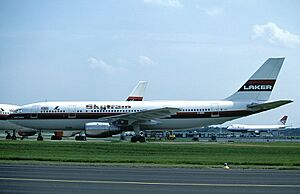
In September 1978, Laker Airways became the first UK airline to order the twin-engine Airbus A300. This was a short and medium-distance wide-body jet. The airline ordered 10 series B4 aircraft with 314 seats in a single class. These were meant to serve a network of up to 666 European Skytrain routes. Most of these low-fare routes would not even touch the UK. This would make it the first airline to fly across Europe.
Laker's European Skytrain plans were opposed by BCal. BCal wanted to expand its European network beyond routes linking Gatwick with Paris-Charles de Gaulle, Amsterdam, Brussels, and Genoa.
Dan-Air and Britannia Airways, two leading UK charter airlines, worried that Laker would be forced to use these extra wide-body planes on the European charter market. This could create too many flights and cause charter prices to drop.
The CAA listened to Laker's plans, as well as those from BCal and other UK airlines. It rejected Laker's main proposal. However, it later gave Laker Airways two scheduled licenses: one for Gatwick – Berlin Tegel and one for Gatwick–Zürich. This happened after British Airways decided to stop its short-haul routes from Gatwick. By the time Laker got these licenses, the airline was having money problems. It had to sell three A300 wide-body planes to save costs. Laker Airways planned to start flights on both routes in spring 1982. They would fly two flights a day each way using its remaining BAC One-Elevens. But the airline went out of business before these flights could start.
Laker started a short-lived scheduled service between Manchester and Zürich in 1981. It operated one flight per day in each direction using a new A300 wide-body plane. This route was the airline's only short-haul scheduled operation. It came about after British Airways stopped its Manchester–Zürich services. Laker's request to take over BA's license made it the UK airline for this route. When Laker later stopped this service and went out of business, Dan-Air became the UK airline for Manchester and Zürich.
More Skytrain Routes to the United States
Laker Airways wanted to become a stronger transatlantic airline. It applied for licenses to serve more US cities. Both the CAA and the Civil Aeronautics Board (CAB) approved the request. This meant Laker could start daily Skytrain services from Gatwick, Manchester, and Prestwick to Chicago, Detroit, Oakland, Seattle, and Washington DC. However, the company did not have planes to use these licenses right away. Its money problems prevented it from adding more aircraft. By the time Laker Airways went out of business, those licenses were still unused. Other airlines eventually received them.
Why Laker Airways Failed
Laker Airways was not strong enough financially to survive the early 1980s recession and competition from bigger airlines. In 1978, a magazine reported that Laker's official company value was £10,000. By 1980, it was £504,000. These numbers were very small compared to BCal (£12 million) and British Airways (£100 million).
Even in June 1971, when Skytrain was first announced, Laker Airways had assets of £1.68 million. While this was over £2 million, it showed that Laker Airways was a small company compared to most major airlines.
The airline's financial weakness was clear because Freddie Laker owned 90% of the company. The rest was owned by his former wife. Also, Laker Airways was part of a larger group of companies based in Jersey, a place with lower taxes. This helped the company save money on taxes and labor laws. However, it also made it riskier for lenders to get their money back.
Besides not having enough capital and having high debts, Laker Airways did not have many valuable assets. Most of its planes were rented, as was its maintenance hangar and offices at Gatwick. Freddie Laker's only personal financial backup was his stud farm and his own money.
Tough Economic Times
Both the UK and US faced a recession in the early 1980s. This meant slow economic growth, high unemployment, high inflation, and high interest rates. During this time, Laker Airways was trying to grow its business, especially Skytrain. The company needed to expand to remain Britain's second-largest independent airline. To do this, Laker Airways borrowed money at high interest rates. These high rates greatly increased the company's borrowing costs and debts.
Even though Laker Airways had many modern wide-body planes, which were cheaper to run, the airline was hit hard. The price of oil suddenly tripled after the Shah of Iran lost power. Laker Airways had to pay high prices for oil because it could not secure future supplies at a fixed rate.
The airline tried to protect itself from changes in the British pound-US dollar exchange rate. This was important because most of its costs were in dollars, but most of its income was in British pounds. The company's problems got worse because it guessed wrong about the pound-dollar exchange rate for the 1981/82 winter season. In 1980 and most of 1981, one pound could buy two dollars. This was because Britain's North Sea oil exports kept the pound strong. Laker Airways did not expect the pound to drop so quickly. This meant they had to pay more for dollars than they had planned, leading to money flowing out during a financial crisis.
The End of Laker Airways
The Skytrain idea had a flaw: it needed many passengers all year round to make money at discount prices. This was true even though Laker Airways had lower costs.
The airline began to fail when Pan Am, a competitor, decided in October 1981 to drop its lowest economy fares by up to 66% where it competed with Skytrain. Laker fought back by offering a discounted premium cabin called Regency Class. After the busy winter season of 1981/82, there weren't enough passengers for four airlines competing across the North Atlantic between January and March. At this point, British Airways and TWA, Laker's other competitors, also dropped their fares. As a result, Laker's passenger numbers and cash flow were cut in half between October 1981 and February 1982. Some also suggested that Laker saw fewer passengers after people started avoiding the DC-10 due to several serious accidents involving that plane type in the late 1970s.
The final blow to Laker Airways came when British Caledonian (BCal) and other European DC-10 operators warned McDonnell Douglas and GE. They said if these companies helped Laker with a rescue contract, they would stop doing business with them. McDonnell Douglas and GE did not go ahead with the rescue. Laker Airways collapsed in the early morning of February 5, 1982, with debts of £270 million. It was the biggest company failure in Britain at that time.
Freddie Laker sued several airlines, including British Airways, BCal, Pan Am, and TWA. He claimed they worked together to put his airline out of business by lowering prices unfairly. They settled out of court for US$50 million. BA made a separate agreement with Freddie Laker personally for £8 million.
In July 1985, BA agreed to pay an extra $35 million. The total money from all parties helped Laker pay off his remaining debts of $69 million. It also allowed BA to become a private company.
After Laker's collapse, its planes were quickly given to other airlines. This included two DC-10-10 wide-body planes that went to British Caledonian Charter. Four BAC One-Eleven 300 narrow-body planes went to BCal. Two Airbus A300B4 wide-body planes went to Air Jamaica.
Incidents and Accidents
On August 17, 1969, a BAC One-Eleven 320L plane (registration: G-AVBX) was flying a charter flight from Klagenfurt, Austria, to Berlin Tegel, Germany. There was an electrical fire in the front cabin area behind the cockpit. The fire started when the plane was 30 nautical miles (56 km) from Hanover, filling the cabin with smoke. This made it very hard to see in the cockpit.
Using emergency oxygen, the captain started an emergency descent from FL250. Air traffic control (ATC) guided them to Hanover Airport. The co-pilot released the air pressure in the plane and tried to open a side window to clear the smoke. The cabin crew lost their public address system and communication with the cockpit during the descent. They had to stop emergency procedures due to lack of time before landing. After a successful emergency landing, the plane stopped quickly off the runway. By the time all 89 people (5 crew and 84 passengers) had left the plane, the fire had burned through the plane's body and was getting more oxygen. No one was hurt. The fire was put out on the ground.
After this incident, the plane manufacturer issued several service bulletins. These listed actions to be taken as required by the UK's Airworthiness Requirements Board (ARB). These bulletins were sent to all One-Eleven operators. The ARB also warned all One-Eleven operators to make sure oxygen leaks do not cause fires. They also said oxygen lines should be kept away from possible fire sources.
Because of this incident, the ARB also started looking closely at how well aircraft parts and furnishings resisted fire. This was because they could be very dangerous in oxygen-fed fires during flight. The flight crew, Captain Basil Bradshaw and First Officer Bernard Sedgwick, later received the Queen's Commendation for Valuable Service in the Air. The cabin crew were praised for their actions during the emergency. The award said that "the crew showed great skill in flying in very serious conditions."
Other Laker Airways Companies
- Laker Airways was an airline based in the Bahamas. Sir Freddie Laker helped start it in 1992 with money from Oscar Wyatt, a Texas oilman. The airline had two Boeing 727-200 Advanced jet planes. In 1994, it flew scheduled non-stop services between Freeport, Bahamas and several US cities. These included Baltimore, Maryland, Chicago, Illinois, Fort Lauderdale, Florida, and West Palm Beach, Florida. By 1995, it also flew to Cleveland, Ohio and Hartford, Connecticut. Laker Airways (Bahamas) closed down in 2005.
- Laker Airways, Inc was a US-registered airline that Sir Freddie Laker co-owned with Oscar Wyatt. It started flying in April 1996 with four rented McDonnell Douglas DC-10-30 wide-body jets. On July 5, 1996, it began low-fare, high-quality scheduled services. These linked Fort Lauderdale in Florida with London Gatwick twice a week. Then, similar services linked Orlando with Manchester and Glasgow Prestwick. These flights had an executive class with leather seats, seat-back TVs, and in-flight meals called Regency Class Service. A daily Miami–Gatwick service was planned for March 1997. Laker Airways, Inc stopped flying in 1998.
- Laker Airways Limited was a company started in England and Wales in June 2013. It was part of a larger aviation training and consulting firm. The company was based near Liverpool John Lennon Airport. It was closed down on September 9, 2014.
Planes Laker Airways Used
Laker Airways used these types of aircraft over the years:
- Airbus A300B4
- Boeing 707 (series −138B and −351B models)
- Boeing 727-200 Advanced (used by Laker Airways Bahamas)
- British Aircraft Corporation BAC One-Eleven (series −300 and −400 models)
- Bristol Britannia (series −102 model)
- McDonnell Douglas DC-10-10
- McDonnell Douglas DC-10-30
- Vickers VC10 (leased to Middle East Airlines and not flown by Laker Airways)
Laker's Lasting Impact
Unlike Laker, most low-cost airlines today only fly short and medium distances. They usually avoid long-distance flights. Almost all attempts to offer low-cost, long-distance flights have ended in failure within a few years.
Sir Freddie Laker greatly influenced Sir Richard Branson. Branson later started Virgin Atlantic.
At London Southend Airport, there is a Lakers bar & restaurant, named after the airline.
See also
- List of defunct airlines of the United Kingdom


